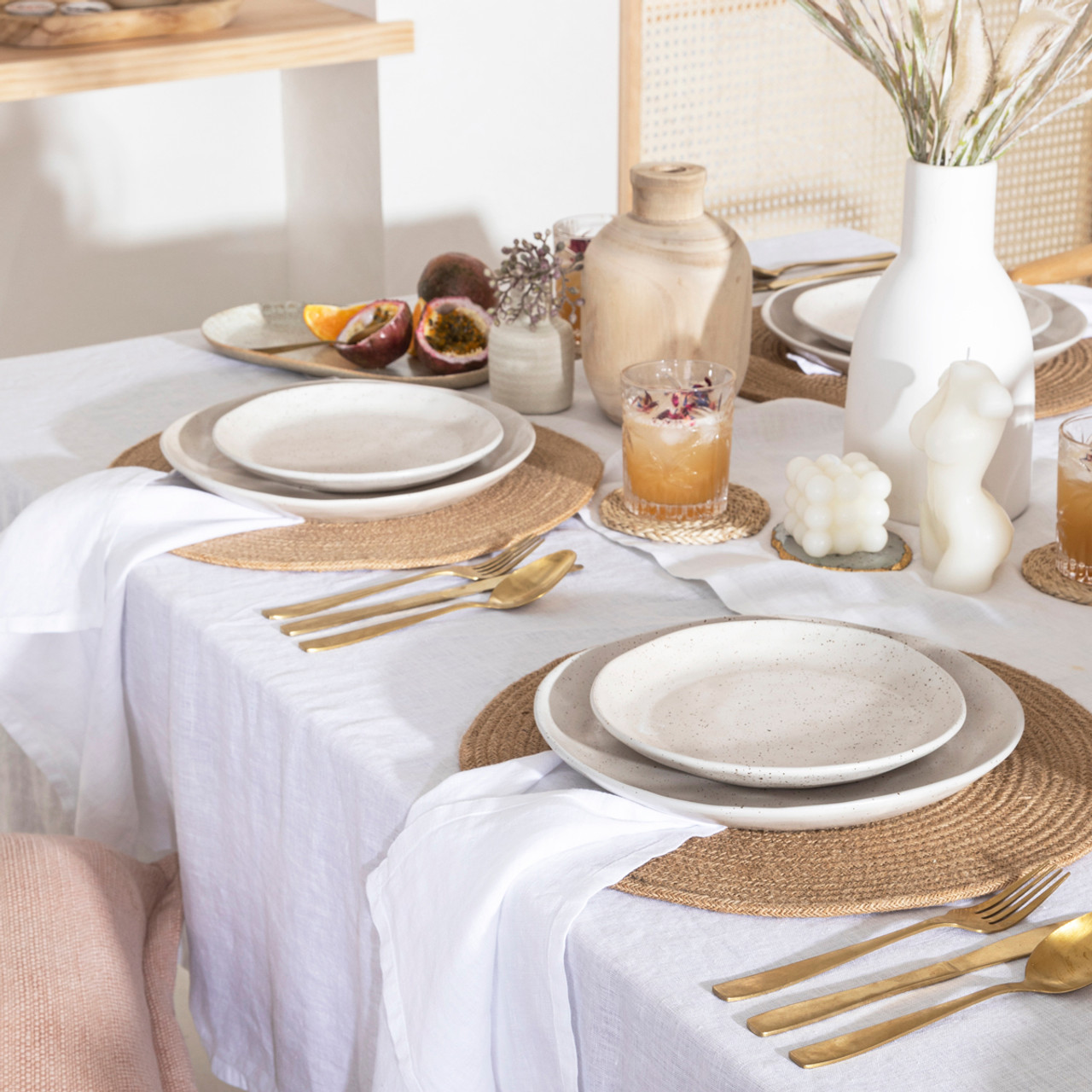Versatile Table Cloths: Styles and Fabrics for Any Kind Of Event
Versatile Table Cloths: Styles and Fabrics for Any Kind Of Event
Blog Article
Bed Linen Textile Advancements: Exploring Modern Trends and Creative Applications in Style and Fabric Industry
From lasting manufacturing techniques to innovative weaving modern technologies, the advancement of bed linen is improving the landscape of the textile industry. As we delve into the worlds of creative layout applications and the appearance of bed linen blends and hybrid fabrics, a brand-new chapter unfolds in which bed linen's function in future fabric technologies takes facility stage.
Lasting Practices in Bed Linen Manufacturing
Sustainable practices in bed linen manufacturing have come to be progressively important in the textile sector's efforts to minimize ecological impact and advertise honest sourcing methods. Bed linen, a natural fiber originated from the flax plant, supplies a variety of benefits such as durability, breathability, and biodegradability. Nevertheless, typical techniques of linen manufacturing can involve significant water intake, chemical use, and energy-intensive procedures.
To deal with these obstacles, several textile makers are adopting lasting techniques throughout the linen manufacturing procedure. This includes sourcing flax from natural ranches that avoid dangerous chemicals and chemicals, executing water-efficient retting methods to remove fibers from the flax stalks, and utilizing green dyes and finishes. In addition, some business are purchasing renewable power resources to power their production centers and reducing waste with recycling and upcycling campaigns.
Technological Improvements in Bed Linen Weaving
With the growing focus on lasting methods in bed linen production, the fabric industry is now observing a surge in technological advancements specifically aimed at transforming the art of linen weaving. These advancements are improving the means bed linen materials are generated, supplying increased efficiency, high quality, and creative thinking in weaving methods.
One of the essential technical improvements in bed linen weaving is the assimilation of digital looms. These advanced looms are equipped with software that permits elaborate and complex designs to be woven with accuracy. By digitizing the weaving process, manufacturers can achieve better consistency and accuracy in their linen materials.
Furthermore, developments in yarn spinning technology have enabled the production of finer and even more sturdy bed linen threads - table cloths. This results in softer and smoother bed linen materials that preserve their quality also after several uses and washes
Furthermore, the development of green dyeing procedures and surfaces for linen fabrics is acquiring grip. These lasting methods not just lower the ecological effect but also accommodate the enhancing customer need for ethically generated fabrics.
Creative Style Applications for Linen
Innovative imaginative strategies are significantly forming the innovative design applications for linen in the fabric industry. Bed linen's natural aesthetic charm and capacity to blend with various other fabrics make it a favorite selection for producing distinct garments and accessories that provide to the eco mindful consumer.
Furthermore, developers are experimenting with linen in home decor, utilizing its breathable and resilient nature to craft elegant home furnishings such as drapes, bed linen, and upholstery. The texture and drape of linen bring a feeling of class and comfort to indoor spaces, adding a touch of beauty to modern-day homes.

Linen Blends and Crossbreed Fabrics

Crossbreed textiles, on the various other hand, take the principle of blending a step better by including additional components such as metallic strings, recycled products, or conductive fibers. These ingenious textiles not only increase the design possibilities yet likewise present practical elements like conductivity, antimicrobial homes, or improved longevity. Crossbreed materials are progressively being utilized in various sectors, including style, indoor layout, see it here and technological fabrics, Learn More Here where the need for multifunctional products gets on the increase.
Bed linen's Role in Future Textile Innovations

In the world of future textile technologies, linen is anticipated to be an essential gamer in the advancement of advanced practical textiles. Scientists and designers are discovering methods to improve bed linen's integral qualities with technological advancements, such as integrating smart textiles, nanotechnology, and performance surfaces. These advancements aim to elevate linen's performance attributes, making it suitable for a more comprehensive series of applications, from activewear to safety clothing.
Moreover, the mix of bed linen with various other all-natural or artificial fibers opens limitless possibilities for producing novel textiles with distinct homes and performances. By leveraging bed linen's features and checking out ingenious blends, the textile industry is positioned to present interesting developments that deal with evolving customer needs and sustainability demands.
Conclusion
To conclude, the exploration of lasting techniques, technical improvements, innovative design applications, linen blends, and its duty in future fabric innovations highlight the continuous evolution of bed linen textile in the modern design and textile industry. With a concentrate on advancement and creative thinking, the versatility and environment-friendly nature of bed linen make it an important material for manufacturers and developers alike, leading the way for more advancements and developments in the area of fabrics.
As we dive right into the realms of creative layout applications and the development of bed linen blends and crossbreed materials, a new chapter unravels in which bed linen's role in future fabric developments takes facility stage.
Discovering the fusion of bed linen with various other materials has led to the emergence of cutting-edge blends and hybrid fabrics in the contemporary fabric industry. Linen blends offer an unique combination of the features of bed linen with those of other fibers, resulting in fabrics that have boosted buildings such as boosted resilience, enhanced draping, and minimized wrinkling.The development of linen blends and crossbreed textiles has set the phase for Linen to play a pivotal function in driving future fabric technologies.In the realm of future textile innovations, bed linen is expected to be a key gamer in the development of innovative practical materials.
Report this page